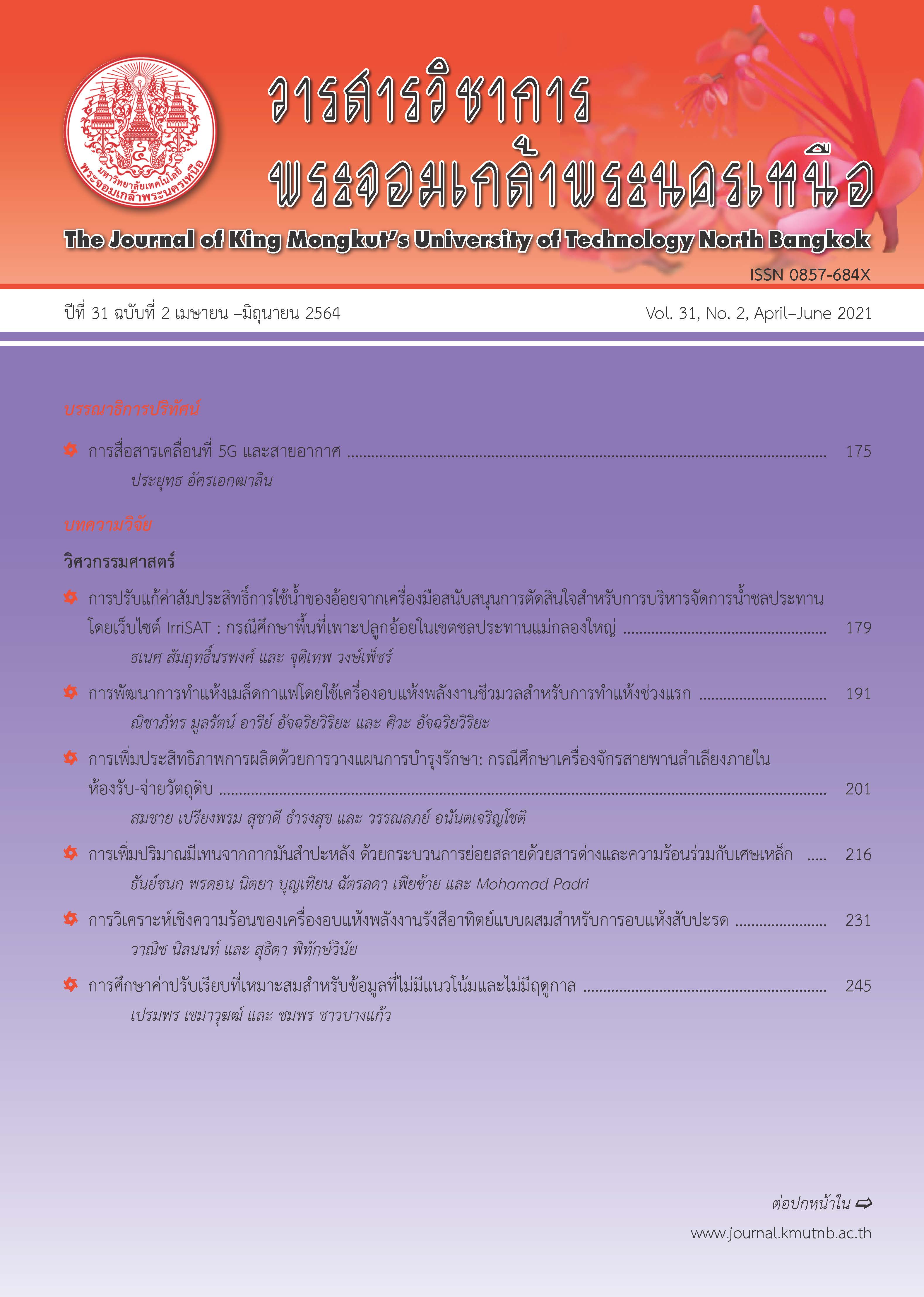การวิเคราะห์เชิงความร้อนของเครื่องอบแห้งพลังงานรังสีอาทิตย์แบบผสมสำหรับการอบแห้งสับปะรด
Main Article Content
บทคัดย่อ
ในงานวิจัยนี้ได้ทำการอบแห้งสับปะรดด้วยเครื่องอบแห้งพลังงานรังสีอาทิตย์แบบผสมโดยการพาความร้อนด้วยการบังคับ ซึ่งประกอบด้วยตัวเก็บรังสีอาทิตย์และห้องอบแห้ง เครื่องอบแห้งนี้มีการพัฒนาด้วยการติดตั้งโดมทรงกลมภายในตัวเก็บรังสีอาทิตย์เพื่อเพิ่มพื้นที่ผิวในการถ่ายเทความร้อน จากนั้นทำการวิเคราะห์สมรรถนะของเครื่องอบแห้งตามหลักการทรงพลังงาน เอกเซอร์จีที่อยู่บนพื้นฐานของกฎข้อที่สองทางอุณหพลศาสตร์ และคำนวณหาค่าความสิ้นเปลืองพลังงานจำเพาะที่ใช้ในการอบแห้ง โดยพบว่าอุณหภูมิที่ออกจากตัวเก็บรังสีมีค่าสูงสุดที่ 68.91°C และอุณหภูมิสูงสุดภายในห้องอบแห้งมีค่า 62.59°C การทดลองนี้สามารถลดปริมาณความชื้นของสัปปะรดจาก 84.97% w.b. ถึง 29.37% w.b. พบว่ามีค่าความสิ้นเปลืองพลังงานจำเพาะ 1.9634 กิโลวัตต์ชั่วโมงต่อกิโลกรัม สำหรับการวิเคราะห์พลังงานและเอกเซอร์จีของการอบแห้งพบว่า มีค่าประสิทธิภาพสูงสุดที่ 50.39% และ 16.05% ผลที่ได้จากการวิจัยนี้สามารถใช้เป็นข้อมูลในการพัฒนาศักยภาพของการใช้พลังงานหมุนเวียนในระบบอบแห้งให้เกิดประโยชน์สูงสุด
Article Details
บทความที่ลงตีพิมพ์เป็นข้อคิดเห็นของผู้เขียนเท่านั้น
ผู้เขียนจะต้องเป็นผู้รับผิดชอบต่อผลทางกฎหมายใดๆ ที่อาจเกิดขึ้นจากบทความนั้น
เอกสารอ้างอิง
[2] Office of Agricultural Economics. (2018). Plant germplasm database pineapple. Ministry of Agriculture and Cooperatives. Bangkok, Thailand [Online]. Available: http://www.oae.go.th/ assets/portals/1/fileups/prcaidata/files/pineapple %2061.pdf (in Thai).
[3] V. Rungsardthong, Fruit Processing Technolog. Bangkok: Text and Journal Publiscation Co.Ltd., 2004 (in Thai).
[4] S. Janjai, I. Masiri, S. Pattarapanitchai, and J. Laksanaboonsong, “Mapping Global solar radiation from long-term satellite data in the tropics using an improved model,” International Journal of Photoenergy, vol. 2013, no. 9, pp. 1–11, 2013.
[5] R. Patil and R. Gawande, “A review on solar tunnel greenhouse drying system,” Renewable and Sustainable Energy Reviews, vol. 56, pp. 196–214, 2016.
[6] S. H. Abdulmalek, M. K. Assadi, H. H. Al-Kayiem, and A. A. Gitan, “A comparative analysis on the uniformity enhancement methods of solar thermal drying,” Energy, vol. 148, pp. 1103–1115, 2018.
[7] W. Jeentada, J. Jareanjit, and P. Tippracha, “Drying experiment of rubber sheet using solar dryer with solar collector installed on top wall of the dryer,” The Journal of KMUTNB, vol. 29, no. 1, pp. 23–33, 2019 (in Thai).
[8] W. Nilnont and S. Phitakwinai, “Drying kinetics of mango using solar tunnel dryer,” The Journal of KMUTNB, vol. 30, no. 1, pp. 36–47, 2020 (in Thai).
[9] Planning Division, (2019, December). Five year government action plan (2020–2022) of the Ministry of Energy. Ministry of Energy. Bangkok, Thailand [Online]. Available: https://energy. go.th/2015/wp-content/uploads/2020/04/ MoEN-Plan-2020-2023.pdf (in Thai).
[10] K. Helrich, Official methods of analysis of association of official analytical chemists. 15th ed., Arlington: AOAC, 1990.
[11] L. S. Paraschiv, S. Paraschiv, and I. V. Ion, “Experimental and theoretical analyses on thermal performance of a solar air collector,” Environmental Engineering and Management Journal, vol. 13, no. 8, pp. 1965–1970, 2014.
[12] A. Lingayat, V. P. Chandramohan, V. R. K. Raju, and A. Kumar, “Development of indirect type solar dryer and experiments for estimation of drying parameters of apple and watermelon,” Thermal Science and Engineering Progress, vol. 161, pp. 1–16, 2020.
[13] S. S. Kishk, R. A. ElGamal, and G. M. ElMasry, “Effectiveness of recyclable aluminum cans in fabricating an efficient solar collector for drying agricultural products,” Renewable Energy, vol. 133, pp. 307–316, 2019.
[14] R. Kumar, S. K. Verma, and V. K. Sharma, “Performance enhancement analysis of triangular solar air heater coated with nanomaterial embedded in black paint,” in Proceedings Materials Today, 2020.
[15] N. Vorayos, W. Wongsuwan, and T. Kiatsiriroat, “Development of solar hot water system in Thailand,” Engineering Journal Chiang Mai University, vol. 16, pp. 55–69, 2009 (in Thai).
[16] M. Akhbari, A. Rahimi, and M. S. Hatamipour, “Modeling and experimental study of a triangular channel solar air heater,” Applied Thermal Engineering, vol. 170, pp. 1–15, 2020.
[17] J. P. Ekka, K. Bala, P. Muthukumar, and D. K. Kanaujiya, “Performance analysis of a forced convection mixed mode horizontal solar cabinet dryer for drying of black ginger (Kaempferia parviflora) using two successive air mass flow rates,” Renewable Energy, vol. 152, pp. 55–66, 2020.
[18] D. K. Rabha, P. Muthukumar, and C. Somayaji, “Energy and exergy analyses of the solar drying processes of ghost chili pepper and ginger,” Renewable Energy, vol. 105, pp. 764–773, 2017.
[19] Y. Bahammou, H. Lamsyehe, M. Kouhila, A. Lamharrar, and N. Abdenouri, “Valorization of co-products of sardine waste by physical treatment under natural and forced convection solar drying,” Renewable Energy, vol. 142, pp. 110–122, 2019.
[20] A. Bejan, G. Tsatsaronis, and M. Moran, Thermal Design and Optimization. John Wiley and Sons, Inc., 1996.
[21] H. Gunerhan and A. Hepbasli, “Exergetic modeling and performance evaluation of solar water heating systems for building applications,” Energy and Buildings, vol. 39, no. 4, pp. 509–516, 2007.
[22] R. Petela, “Exergy of undiluted thermal radiations,” Solar Energy, vol. 74, no. 6, pp. 469–488, 2003.
[23] A. Ghiami and S. Ghiami, “Comparative study based on energy and exergy analyses of a baffled solar air heater with latent storage collector,” Applied Thermal Engineering, vol. 133, pp. 797–808, 2018.
[24] K. Sacilik, R. Keskin, and A. K. Elicin, “Mathematical modelling of solar tunnel drying of thin layer organic tomato,” Journal of Food Engineering, vol. 73, no. 3, pp. 231–238, 2006.
[25] N. Poomsa-ad, S. Maihom, and L. Wiset, “Impingement drying of ‘Phulae’ pineapple: Its drying kinetics and performance of dryer,” in Proceedings The 14th Mahasarakham University Research Conference, 2018, pp. 127−133.
[26] M. M. I. Chowdhury, B. K. Bala, and M. A. Haque, “Energy and exergy analysis of the solar drying of jackfruit leather,” Biosystems Engineering, vol. 110, no. 2, pp. 222–229, 2011.
[27] M. Abuşka, “Energy and exergy analysis of solar air heater having new design absorber plate with conical surface,” Applied Thermal Engineering, vol. 131, pp. 115–124, 2018.
[28] D. V. N. Lakshmi, P. Muthukumar, A. Layek, and P. K. Nayak, “Performance analyses of mixed mode forced convection solar dryer for drying of stevia leaves,” Solar Energy, vol. 188, pp. 507–518, 2019.
[29] A. K. Karthikeyan and S. Murugavelh, “Thin layer drying kinetics and exergy analysis of turmeric (Curcuma longa) in a mixed mode forced convection solar tunnel dryer,” Renewable Energy, vol. 128, pp. 305–312, 2018.

